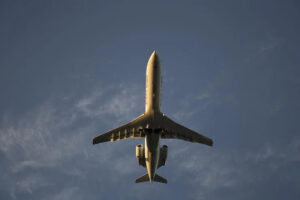
Air cargo rates – refracting the dark forces of stagflation
The global economy seems to be grinding on remorselessly towards a new era of stagflation – with prices rising but growth stalling. Towards conditions not witnessed last since the troubled era of the 1970s. There are of course various reasons underlying this trend, including the Covid pandemic – and the huge fiscal and monetary response around the world; ensuing higher demand and tighter labour markets; and Russia invading Ukraine, adding a further shock to key commodity markets like oil and gas, agriculture and food. But how is all this playing out in terms of global trade – and the not insignificant role of the air freight sector in facilitating it? Well, many economists think Europe may already be in recession – with the added risk that Russia could simply pull the plug on the supply of gas to Germany hanging like a sword of Damocles over prospects for the whole region. Recent surveys in the US, such as the widely followed Atlanta Fed GDP Now Forecast, are pointing towards a sharp slowdown there too. Meanwhile, growth in China – in recent years the main engine room of global growth – was squeezed down to only +0.4% in Q2 following severe local lockdowns in key economic centres like Shanghai. Although global growth is clearly weak and falling, which may normally ease inflationary pressures, economists worry that this time inflation may be more sticky – given not least tighter labour markets in the developed world post-Covid. That gives workers more leverage to press for higher wages – which then threatens a wage-price spiral. There are other reasons too, such as the trend away from ‘just in time’ towards ‘just in case’ supply systems – after the shock of the pandemic, and subsequent scramble for PPE and vaccines, demonstrated how important it is for countries to secure supplies of ‘strategic’ goods. ‘Just in case’ may be a safer approach to maintaining supplies, but it is usually more expensive too. Arguably, the biggest factor in the growth of free trade and low inflation in the last 40 years was the opening up of China to the West. But the expansion of global trade that sparked off began to run out of steam and go into reverse after the global financial crisis of 2008 – a new trend that has accelerated since Covid and the war in Ukraine. Some are already calling this a new era of ‘deglobalisation’. There are also medium to longer term demographic trends in China that point towards a slowdown there anyway from the high growth rates of recent decades. Instead of exporting deflationary pressure, as before, some expect China could soon be exporting inflationary pressure. Hence the troubling outlook for stagflation. Economists and money managers don’t all agree about whether it will lead to a big recession – with some arguing that it may be just a shallow or ‘technical recession’ given the high levels of savings built up during the pandemic. But the outlook does not look great. Arguably, all these big geopolitical and macroeconomic trends are already reflected in the weekly data on air freight prices published by TAC Index. After rising sharply during 2020 and 2021, air freight prices globally have eased off this year, according to the TAC data – with the overall Baltic Air Freight Index (BAI00) up only +15.6% year-on-year through 01 August. And that was against the backdrop of much higher jet fuel prices, up more than +85% YoY according to Platt’s data. The TAC data for routes between specific locations and regions look even more interesting. For instance, the index number for China to US overall was up only +1.6% YoY – while US to China was up a huge +69.0% over the same period. Does that reflect a shortening of US supply chains – and movement of production for the US market away from China either into the US or to other locations? And rising demand from China for key inputs from the US? Perhaps time will tell. Looking at alternative locations to source supplies, the latest data for India to US routes had been showing a significant increase in air cargo prices at the start of the year as high as +66.5% YoY but now pricing trending downwards to – about -4.8% YoY – a significant decline. Similarly, Vietnam to US has also seen a more exaggerated downward trend with highs at the start of year touching +198.0% YoY and has now dropped to -33.6% YoY based on the latest numbers. At the same time, air freight prices between China and Europe have been rising strongly in both directions: China to Europe up +40.1% YoY, with +48%-plus increases for both Shanghai-Frankfurt and Shanghai-Amsterdam routes. And an even more eye-popping increase of +95.9% YoY in rates for Baltic Air Freight Index (BAI23) Frankfurt to China overall. Alongside the US to China numbers, perhaps the surge from Frankfurt reflects some latent growth in the Chinese economy – waiting to be unleashed after key inputs for the economy are urgently imported by air from Germany. After a ‘summer lull’, the peak season for air cargo is anticipated soon – and will be a key indicator of how much real growth in trade might offset those dark forces of stagflation. Read our freight blog for the latest insights and trends in the logistics industry.

